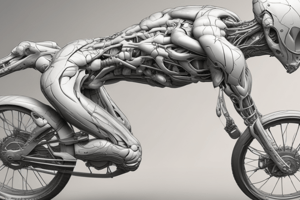Podcast
Questions and Answers
Which statement best describes inactive posture?
Which statement best describes inactive posture?
- It includes actions such as walking and running.
- It involves maximum force generation from various muscle groups.
- It is characterized by reduced muscular activity and is suitable for rest. (correct)
- It requires coordinated muscle activity to maintain stability.
What is a potential effect of poor posture on the body?
What is a potential effect of poor posture on the body?
- Enhanced digestive efficiency.
- Decreased pressure on the spine and surrounding structures.
- Increased risk of falling due to balance issues. (correct)
- Improved joint mobility and flexibility.
What distinguishes dynamic posture from static posture?
What distinguishes dynamic posture from static posture?
- Static posture requires more energy than dynamic posture.
- Dynamic posture involves movement of body segments, while static posture does not. (correct)
- Static posture is the preferred position during exercise.
- Dynamic posture is focused on maintaining alignment without movement.
Which of the following actions primarily utilizes active posture?
Which of the following actions primarily utilizes active posture?
Which of the following is NOT a consequence of faulty posture?
Which of the following is NOT a consequence of faulty posture?
Which postural change is characterized by an increase in the curvature of the thoracic spine?
Which postural change is characterized by an increase in the curvature of the thoracic spine?
What is the effect of pelvic organ prolapse in women related to?
What is the effect of pelvic organ prolapse in women related to?
What is the primary feature of forward head posture?
What is the primary feature of forward head posture?
What condition is characterized by excessive flattening of the lumbar region?
What condition is characterized by excessive flattening of the lumbar region?
Which of the following describes a knee that is hyperextended beyond the normal physiological range?
Which of the following describes a knee that is hyperextended beyond the normal physiological range?
What is the consequence of a flat foot condition?
What is the consequence of a flat foot condition?
What indicates a scoliotic condition as seen from the frontal plane view?
What indicates a scoliotic condition as seen from the frontal plane view?
What alteration in posture is associated with a tilted pelvis?
What alteration in posture is associated with a tilted pelvis?
Flashcards are hidden until you start studying
Study Notes
Definition of Posture
- Posture refers to the body's position, whether supported during inactivity or through coordinated muscle action for stability.
- Inactive posture is assumed during rest or sleep, minimizing essential muscle activity.
- Active posture involves the use of multiple muscles to maintain static or dynamic positions.
Types of Postures
- Static Posture: Body segments aligned in specific positions; includes standing, sitting, lying, and kneeling.
- Dynamic Posture: Involves movement of the body or its segments; includes activities like walking, running, jumping, throwing, and lifting.
Posture and Health
- Poor posture contributes negatively to health, stressing joints and leading to various health issues.
Effects of Faulty Posture
- Increases spinal pressure, leading to injury or degeneration.
- Causes neck, shoulder, and back pain.
- Decreases overall flexibility.
- Impairs joint movement and balance, increasing fall risk.
- Harms digestion and induces breathing disorders, impacting heart health.
- In women, can disrupt core muscles, leading to incontinence or pelvic organ prolapse.
Age-Related Postural Changes
- Common changes include thoracic hyperkyphosis, loss of lumbar lordosis, and decreased plantar arch.
Postural Assessment
Sagittal Plane (Lateral View)
- Normal Posture: Erect head, retracted shoulders, normal spinal lordosis/kyphosis, neutral pelvis, extended knees.
- Faulty Posture: Forward head, rounded shoulders, flattened/hyperlordotic cervical or lumbar spine, anterior/posterior pelvic tilt, hyperextended knees.
Frontal Plane (Anterior View)
- Normal Posture: Head in mid position, level shoulders, straight spine, level pelvis, physiological valgus knees, normal medial arch.
- Faulty Posture: Tilted/rotated head, dropped shoulder, scoliosis, dropped pelvis, knock knees/bow legs, flat foot.
Frontal Plane (Posterior View)
- Normal Posture: Mid position head, level shoulders, no scapular winging, straight spine, level pelvis, physiological valgus knees, neutral foot.
- Faulty Posture: Tilted/rotated head, dropped shoulder, scapular abduction/adduction, scoliosis, dropped pelvis, knock knees/bow legs, foot deformities like calcaneovalgus/varus.
Studying That Suits You
Use AI to generate personalized quizzes and flashcards to suit your learning preferences.




